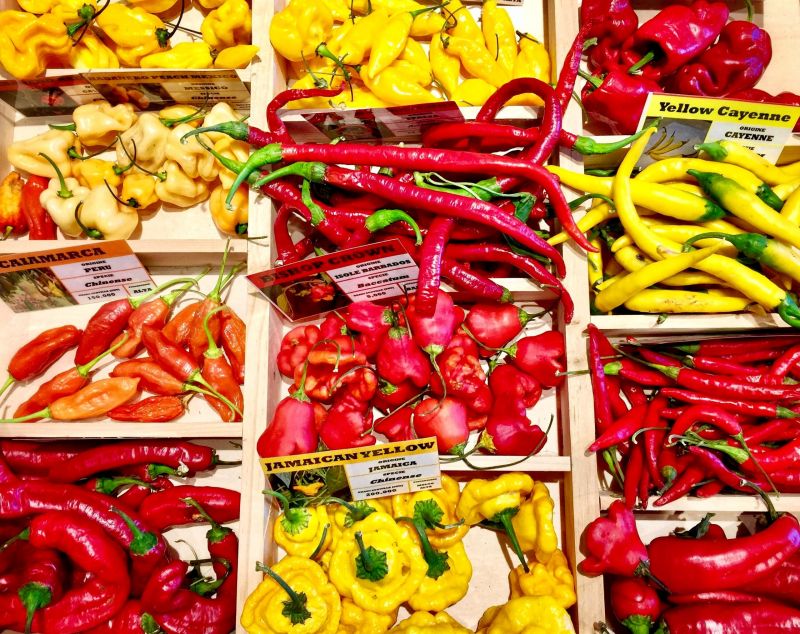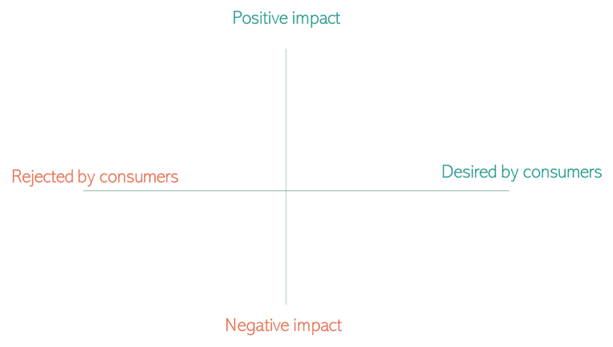Competing successfully in the sustainability arena

Opinion piece by Durk Bosma, previously published on GreenBook
Having worked as a researcher in sustainable food for the last 5 years, I have seen an incredible amount of sustainable innovations and brands hit the market. Every food company I know is working hard on making their impact smaller or even net-positive, by developing products that are better for the world and consumers. But not all of them succeed. Simply making products that are better for the planet or society isn’t enough. In order to be successful in sustainable marketing you need to dig a little deeper. In this article I will explain how consumer insights can help to successfully position sustainable brands and innovations.
Impact vs desire framework
Unfortunately there is no clear 1-to-1 correlation between how good a product is for the planet and how much consumers want it. To illustrate this we use the framework below. It consists of 2 simple axis: impact and desirability.
Your sustainability improvements determine where you stand on the vertical axis, impact. Your marketing efforts will determine how far you move to the right on the desirability axis.

Ideally, every sustainable food innovation is in the right top quadrant. This is where stuff sits that consumers really want and is good for the planet. It means that people will consciously choose these brands and products over alternatives that are less sustainable. As an example, think of the brand Patagonia. Very activist and very popular, partly because consumers believe and support the mission of the brand (and also they have high quality products, are well-known, etc.).
However, many sustainable innovations are in the top left corner. Here we find products that have a positive impact, but are not very popular (yet) among consumers. They feel they need to make a sacrifice if they use these products, give something up. Products in this area might be less tasty, more expensive, take more effort to recycle, etc. Think of paper straws as a substitute for plastic ones. No one really wants those. Just think of the mouthfeel when the paper becomes mushy. A less sustainable alternative that would not become mushy after a few sips, would be more appealing to consumers.
In the left bottom quadrant we find products and brands that are already receding. They do harm to the planet or society and consumers don’t want them (anymore). It’s good that these products are dying out. But we have to remember that they don’t end up here by themselves. It requires a coordinated effort of communication, policy development and the development of better alternatives. As an example think of petrol powered cars. They are moving towards this quadrant, because of the availability of electrical vehicles (and charging stations), subsidies & taxes and an increasing awareness of the negatives effects of using fossil fuels.
On the bottom right we find the products that are still very much in vogue, although they have a negative planetary or societal impact. The clearest example is meat. Scientists (and more and more consumers as well) agree that eating meat is not a good idea and that a more plant-based diet is needed to feed the world in the future. But still, many consumers find it difficult to reduce the consumption of animal-based products. Or don’t feel the need or desire to do so.
Understanding the dynamics in your category allows you to make well thought out strategic choices. These choices form the foundation for sustainable brand development, product development and communication. So you need to know where in the framework your product or brand sits. And where your competitors are. And even more importantly, understand what determines the position on both axes, in the eyes of the consumers. And in order to achieve this understanding you need to spend some time getting to know your target audience.
Three ways to make impact
Let’s have a look at the vertical axis, the impact axis. Impact is multi-faceted. In a myriad of ways the production and consumption of food products has an impact on the world. These ways can be categorized as:
- ecological impact
- social impact
- direct impacts on the health and well-being of those who consume it
Just think of chocolate. The raw materials (cocoa beans) are produced in tropical areas, mainly in the western part of Africa. It grows in the shadows of tropical forests and doesn’t require loads of fertilizers and pesticides. Most farmers work in a way that is considered organic. However, growing demand leads to deforestation, erosion and loss of biodiversity.
A major problem is the fluctuating and low price farmers receive for their cocoa. They often earn no more than $2 a day. Poverty leads to a lack of education, health care, electricity and clean water. Poverty also encourages child labor. The farmers depend on a few big players in the market who buy and process the cocoa. Several fairtrade organizations try to improve the situation of the farmers by offering them a minimum price for their produce.
Both positive and negative health effects are attributed to chocolate. Some say eating chocolate can help prevent cardiovascular diseases, causes migraine and increases alertness. Not always are the claims true, in many cases the amount of active substances in chocolate is too low to have any measurable effect. One thing is undisputed though and that is chocolate is a product that is very high in calories and that eating too much of it is not good for you. Most variants contain between 70% and 80% sugar and fat.
Actual vs perceived impact
It is very important to make a distinction between actual, objective impact and the impact as perceived by the consumers.
Actual impact can be established in a scientific way, for instance by means of a product life cycle assessment (LCA) that looks at the measurable impact a product has in many different ways.
Perceived impact is what consumers think the impact is. They use their own criteria, background knowledge and their own perceptions to determine this. And to find out what these criteria and perceptions are we need insight into their hearts and minds. Because it’s the perceived impact that influences whether the buy a product (or not).
And there is a discrepancy between what scientists consider sustainable and what consumers thinks. LCA’s tend to look at objectively measurable and environmental criteria. Some things consumers find important are not included. Wages of workers and the quality of life of animals used in the production of food products are examples of these elements. From an environmental perspective keeping a lot of chickens in a small confined space can be sustainable. Using a small number of resources you can produce a lot of chicken meat this way. But looked at from many other perspectives, like animal welfare, this way of producing meat is rather undesirable.
In a recent study we did among European consumers, we found that the top 3 of most important elements they wanted to be included in a sustainability logo for food products, were water usage, the use of pesticides and the recyclability of the packaging. These are all elements scientists would take into account, although maybe not as the 3 most important ones. But on the 4th and 5th rank consumers place healthiness and animal friendliness of the product. These are typical elements that scientist would not take into account in an LCA. On the bottom of the list of priorities of consumers we find yield of the crops and resilience for change in weather conditions. These are typically elements that are of very high importance in determining the overall sustainability, in the eyes of scientists. In short, when it comes to defining what is sustainable food, consumers and scientists disagree to a large extent.
In an ideal situation however, there is an overlap between how sustainable a product is in the eyes of consumers and scientists. Not just the overall ‘score’ but also how that score is built up, in other words, what elements make up the sustainability of product. And if consumers and scientists agree, it can lead to consumer demand for a sustainable products. They want the product, because they believe it is good for the planet (and it actually is).
When consumers and scientist disagree about whether or not something is sustainable, the phenomenon of green washing is lurking around the corner. This happens when claims or suggestions about sustainability are made that are not backed up by objective measurements.
Understanding sustainability in your category
The sustainability arena is big and in many markets not completely mapped out, particularly with break-through innovations. In order to understand the possibilities you need to find a clear answer to the following question:
In what way(s) can products or brands in this category contribute to a better world, now, but also in the future.
The answer can either be doing something that is good (like hire workers with disabilities), or at least not doing something that is bad (like pollute).
As explained before, the answer can be found in one of these 3 categories:
- Ecological
- Social
- Health and well-being
Suppose you work for a sustainable chocolate brand. You can choose in which area to compete. You could make chocolate that is healthier and contains less calories. Or grown in ways that prevent deforestation and support biodiversity. Or provide fairer prices for farmers and better wages for workers in the chocolate supply chain. Like Dutch chocolate brand Tony’s Chocolonely did. They choose the second element and build their brand around the concept of ‘slave-free chocolate’. And very successfully. They quickly grew to be one of the biggest chocolate brands in the Dutch market. Obviously this is not just the effect of their sustainability efforts and communication around them, but also because the quality of their product, flavours, distribution, etc. But still, it was the strategic choice for a specific element of sustainability and the consistent and relentless execution of this choice that set them apart from the competition as a newcomer in the otherwise mature and rather boring chocolate segment.
If you are ready to make a strategic choice about where to compete, it’s time to reach out to your target audience. You need to know their perspective, what they find relevant. Questions to be answered:
- What are relevant elements of sustainability in my category, from the perspective of the consumer?
- Ecological
- Social
- Health and well-being
- Exactly how relevant is each element?
Once you have the answers, you are almost ready to pick your place in the arena.
Communicating impact to create desire
But first, it’s time to investigate the horizontal axis, which shows how much your audience wants your product or brand. Obviously this is only partly determined by the sustainability of your offer. All elements of the marketing mix play a role here. Simply product performance, but also the price plays a role. Marketing a product in a successful way means adding functional and emotional benefits for the consumer. This is mostly the field of ‘regular’ marketing.
Obviously you need to know your position on the desirability axis. In other words, how much do consumers desire your innovation/product/brand (overall). You can measure this in different ways, like purchase intention, Net Promoter Score or whatever measurement is most suitable. Keep in mind here that knowing your own position is not enough. You need to know if your product is doing better than available alternatives. Because only then will consumers choose yours.
And since we are interested in sustainable marketing, we would like to focus on the question: In what way does the perceived sustainability of the product lead to (or stands in the way of) consumer acceptance?
In order to be persuasive, communication about sustainability a product or a brand must meet these four criteria:
- Clear
- Credible
- Effective
- Fit values of consumers
Please note, communication must be clear, credible and effective in the eyes of the target group. Not only in the eyes of the scientist who perform the life cycle assessment or the entrepreneur or brand that wants to make a specific claim.
So the questions you need to answer with the help of your target audience are:
- How well does my product/brand perform on the elements that determine whether or not consumers find my product sustainable? In other words, is the impact:
- clear,
- credible,
- (perceived as) effective
- and does it fit the values of the consumer?
Combing your performance with the importance of the product elements or characteristics, will teach you how to ensure consumers will chose your sustainable brand or product. If there are sustainability elements that are important in the eyes of consumers and your product performs well on, these are your unique selling points. In other words, the (sustainable) reasons why consumers buy your product. Be good and tell it!
There may also be elements that are important to consumers, but your product is not doing well (enough). Think of meat substitutes. Taste, mouthfeel and healthiness are important, but many products in this category are not as good as the meat products they replace. In which case, you can only be successful in the long term if you find ways to improve the performance of the product.
There may also be elements that your product performs well on, but consumers do not find them important (yet). For instance, one of the downsides of conventional agriculture is that it depletes the soil, which can only be compensated by adding (chemical) nutrients. Organic agriculture does much better in this sense, it improves the condition of the soil. But not many consumers realise that the condition of the soil is an important factor, contributing to food security in the long term and biodiversity. So here lies a communication challenge if you want to promote organic products. You need to explain why this element is important to make more consumers choose organic food.
Once we deeply understand the role of sustainability in consumer decision making in your product category, ‘regular’ marketing takes over. Most marketing professionals are perfectly capable of developing products and communicating in an impactful way. Sustainable marketing is a little more difficult, but with the right consumer insights contributing to a better world by means of successfully marketing sustainable options becomes highly achievable.
We believe that understanding consumers is key to making the food system more sustainable. Successful innovation and impactful communication require a solid foundation of consumer insight.
We are the insights partner of choice for food companies and non-profits that aim to have a positive impact on society and our planet. Together we empower consumers to make food choices that are good for them as well as for the planet.
The Hague Tech - Waldorpstraat 5 - 2521CA - The Hague
(+31) (0)70 2042314 - Info@futureoffood.institute
Contact
Fill in this form and we'll be in touch shortly!
Newsletter
Do you want to receive a monthly dose of insights, opinions and events? Please subscribe to our newsletter.










